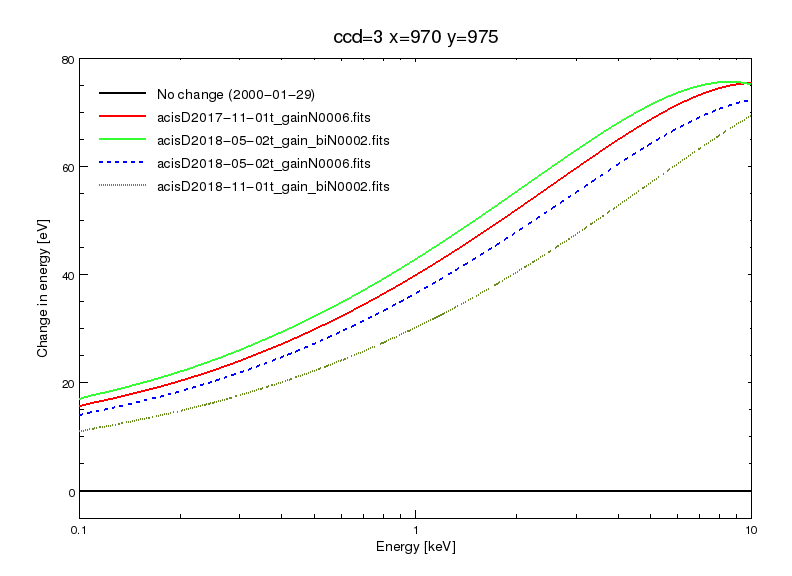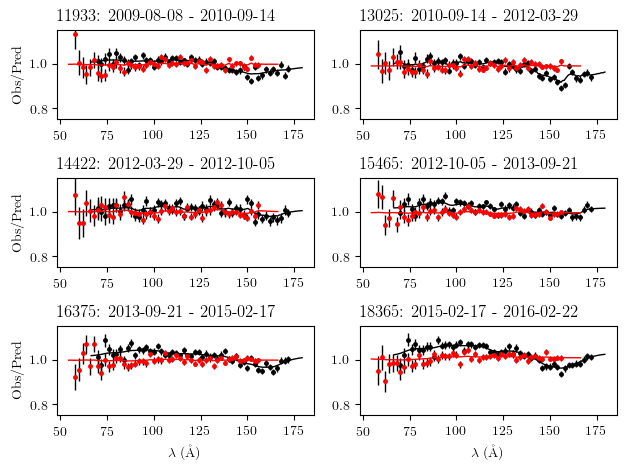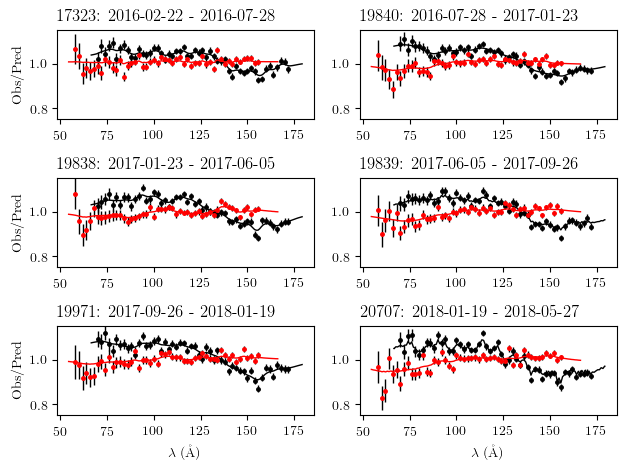CalDB 4.8.3 Public Release Notes
Public Release Date: 23 May 2019
SDP Installation Date: 2019-05-24T01:06:00 (UTC)
I. INTRODUCTION
CalDB 4.8.3 is an upgrade to the Chandra CalDB, which includes the following items:
- ACIS T_GAIN Epoch 75+76 Updates
- Corrections to ACIS BADPIX FP_TEMP Boundary Conditions
- HRC-S GAPLOOKUP TABLE: KEYWORD ADDITIONS
- HRC-S QEU N0011 UPGRADE
- Retiring ACIS 2017 PROVISIONAL T_GAIN Files
For the CIAO 4.11 / CalDB 4.8.3 release notes see How CalDB 4.8.3 Affects Your Analysis.
II. SUMMARY OF CHANGES
A. ACIS T_GAIN Epoch 75+76 Updates
| Location: | $CALDB/data/chandra/acis/t_gain/ |
| Filenames: | acisD2018-05-02t_gainN0005.fits acisD2018-05-02t_gainN0006.fits acisD2018-11-01t_gainN0002.fits acisD2018-11-01t_gain_biN0002.fits |
The ACIS Calibration team has released the semiannual time-dependent gain (T_GAIN) updates from analysis of ECS data for the period Aug 01, 2018 through Jan 31 2019 (epochs 75+76), and hence the above files have been generated as a result, for immediate release. The secular time variations in the corrections calculated from these new data are similar in magnitude and direction to previous upgrades, wherein maximal changes are a few percent or less of the deltaE/E value. This time around, it appears that the gain adjustments near the ACIS-S aimpoint are more significant than those at the ACIS-I aimpoint, and this includes the previous epochal period (epoch 73+74, Feb 01 - July 31 2018) which is now finalized.
NOTE: Users with observations taken between (DATE-OBS=) 2018-05-02T12:00:00 and 2019-11-01T00:00:00 are advised to reprocess with their data with finalized versions of the applicable T_GAIN files. Users with observations taken since 2018-11-01T00:00:00 will have access to an updated provisional T_GAIN file (one of the version N0002 filenames above); They will not however have a finalized T_GAIN until after Epoch 78 (May 01 - July 31, 2019) is completed.
For a presentation of the specific values, see the Technical Details Section below. There has been a significant change in the procedure for generating the time-dependent gain corrections from the ECS data, which improves the calibration results, but does not affect users in any other way. For more information on the ACIS time-dependent gain in general, see the ACIS T_GAIN why page.
PIPELINES/TOOLS AFFECTED:
ACIS Level 1 pipeline tool acis_process_events.
CIAO script chandra_repro uses acis_process_events to reprocess ACIS observation data.
THREADS AFFECTED:
Reprocessing Data to Create a New Level=2 Event File
B. Corrections to ACIS BADPIX FP_TEMP Boundary Conditions
| Location: | $CALDB/data/chandra/acis/badpix/ |
| Filenames: | acisD2000-11-28badpixN0003.fits acisD2000-11-28badpix_secN0003.fits |
A minor header change has been made to the focal plane temperature (FP_TEMP) boundary condition in each extension of the two BADPIX files above, in order to bring these boundary conditions into exact agreement with the standards previously set for currently-effective ACIS calibration data. The actual change is to alter the upper and lower boundaries by +0.01K. This change is being done to address possible warmer- than-usual ACIS observations to be taken in the future of the mission. It does NOT affect any existing observations or calibration data sets, and users may as well take no heed of it. Specific details are given in the Technical Details Section below.
PIPELINES/TOOLS AFFECTED:
This change is so minor that there is essentially no affect on current or previous processing of ACIS data.
THREADS AFFECTED:
None.
C. HRC-S GAPLOOKUP TABLE: KEYWORD ADDITIONS
| Location: | $CALDB/data/chandra/hrc/gaplookup/ |
| Filename: | hrcsD1999-07-22gaplookupN0005.fits |
The HRC-S calibration team has uncovered a small error in the determination of the plate edge positions in the "V"-direction (along the length of the array) in the HRC Level 1 processing. The error has been traced to certain offsets that have up until now been hard-coded numbers in hrc_process_events. Corrected offset values have been determined, and SDS (Jonathan McDowell) has acknowledged that these values should not be hard-coded into the tool, but instead ought to be considered analysis reference data, and hence belong in CalDB. These corrections allow a better calibration of the LETGS energy scale.
In the software, hrc_process_events will be modified to look for these new keywords in the GAPLOOKUP headers in DS 10.8, expected for release in June 2019. It has already been modified for CIAO 4.11, released in December 2018, so that the users will have access to these changes immediately upon upgrading to CalDB 4.8.3.
It has been decided that the appropriate place to put these values is in the "U_DEGAP_LOOKUP_S#" extension headers of the HRC-S GAPLOOKUP tables, where "#" is the plate number 1, 2, or 3. The header keywords are to be named HRC_OFF_X and HRC_OFF_Y, where X designates the focus direction, and Y corresponds to the direction along the array, same as the "V" direction. Further details, including the specific values of these offsets are given in the Technical Details Section below.
PIPELINES/TOOLS AFFECTED:
HRC Level 1 processing tool hrc_process_events
CIAO script chandra_repro uses hrc_process_events to reprocess HRC-S observation data. Only HRC-S data are affected by this change.
THREADS AFFECTED:
Reprocessing Data to Create a New Level=2 Event File for HRC-S data sets only.
D. HRC-S QEU N0011 UPGRADE
| Location: | $CALDB/data/chandra/hrc/qeu/ |
| Filenames: | hrcsD1999-07-22qeuN0011.fits hrcsD2000-01-01qeuN0011.fits hrcsD2001-01-01qeuN0011.fits hrcsD2002-01-01qeuN0011.fits hrcsD2003-01-01qeuN0011.fits hrcsD2004-01-01qeuN0011.fits hrcsD2005-01-01qeuN0011.fits hrcsD2006-01-01qeuN0011.fits hrcsD2007-01-01qeuN0011.fits hrcsD2008-01-01qeuN0011.fits hrcsD2009-01-01qeuN0011.fits hrcsD2009-08-08qeuN0011.fits hrcsD2010-09-14qeuN0011.fits hrcsD2012-03-29qeuN0011.fits hrcsD2012-10-05qeuN0011.fits hrcsD2013-09-21qeuN0011.fits hrcsD2015-02-17qeuN0011.fits hrcsD2016-02-22qeuN0011.fits hrcsD2016-07-28qeuN0011.fits hrcsD2017-01-23qeuN0011.fits hrcsD2017-06-05qeuN0011.fits hrcsD2017-09-26qeuN0011.fits hrcsD2018-01-19qeuN0011.fits hrcsD2018-05-27qeuN0011.fits hrcsD2018-09-26qeuN0011.fits |
As the LETGS calibration team has monitored the accelerated rate of decay in the HRC-S quantum efficiency as a function of wavelength, they have elected to replace the current set of time dependent QE Uniformity (QEU) files (version N0009) with another new set of files, version N0011. One additional file has been added to the set, with new effective date of 2018-09-26T00:00:00, so that the set includes 25 files now. See the technical details section below for illustrations and details of the derivation of these new QE Uniformity corrections. In general, this latest set accounts for an additional 2.5% of QE loss over the 0.060 - 0.652 keV range; above that range, the change is minimal.
See also the why page for more general information on the HRC-S QE/QEU corrections in the CalDB.
CIAO SCRIPTS/TOOLS AFFECTED:
See the script fluximage, which uses mkinstmap
THREADS AFFECTED:
For exposure-corrected imaging analysis with HRC-S, see the thread:
For grating spectroscopy with the LETG/HRC-S, see the thread:
E. Retiring ACIS 2017 PROVISIONAL T_GAIN Files
| Location: | $CALDB/data/chandra/acis/t_gain/ |
| Filenames: | acisD2017-05-02t_gain_biN0002.fits acisD2017-05-02t_gainN0002.fits acisD2017-11-01t_gain_biN0002.fits acisD2017-11-01t_gainN0002.fits |
In order to minimize the size of the CalDB, we have annually removed from the CalDB distribution the provisional ACIS T_GAIN files (those with version N0002) after they have been upstaged for at least one year by the permanent ones. It has become time to remove those provisional files from the year 2017 from the distribution. Users may delete these specific files from their own CalDB installations to reduce the space taken up on their own systems; however the deletion must be done only of these named files above, and no others!
PIPELINES/TOOLS AFFECTED:
None.
THREADS AFFECTED:
None.
III. TECHNICAL DETAILS
A. ACIS T_GAIN Epoch 75+76 Updates
The ACIS T_GAIN epoch 75+76, combining two quarterly epochs, and covering the period of Aug 01, 2018 through Jan 31, 2019 has recently been completed, and the ACIS External Calibration Source (ECS) radiation zone data has been reduced as per a significanly modified procedure, to generate the time-dependent gain correction tables for this period. The procedural modifications were made to address the decreasing statistics available from the ECS due to its natural decay in count rates. The two epochs are being combined, as is now the standard practice with T_GAIN upgrades, to produce a single new T_GAIN correction update.
The original method of derivation for the ACIS T_GAINs is given in the memorandum "Corrections for time-dependence of ACIS gain", posted on ACIS Calibration web page ACIS TGAIN.
The magnitudes (in eV) of the new gain corrections, versus photon energy, are given in Figs. 1-3 below. The secular variations are as follows: Specifically from -5% at ~0.l keV to -2% at ~10 keV for ACIS-I the aim point; for the ACIS-S aim point, the variations are approximately (+)5% for the full range. Fig. 1 below gives the corrections for the ACIS-I aimpoint on chip ACIS-3, for the CTI-corrected case, which is the only one applicable to FI chips. Figure 2 gives the corrections for the ACIS-S aimpoint on ACIS-7, for the case where the BI chips are CTI-corrected. Finally Fig. 3 gives the corrections for ACIS-7 for NON-CTI-corrected BI chips. These would be relevant to GRADED DATAMODE observations with ACIS-S, for example.

Fig. 1: Time dependent gain corrections versus photon energy for the ACIS-I aimpoint on ACIS-I3
(CHIPX=970, CHIPY=975) for the new and recent comparable T_GAIN files in CalDB. The parallel CTI
correction for the FI chips has been applied to all data.

Fig. 2: Time-dependent gain corrections versus energy for the ACIS-S aimpoint on ACIS-7
(CHIPX=210, CHIPY=520) for the new and recent comparable CalDB T_GAIN files. For these data,
the series and parallel CTI correction for the BI chips has been applied.

Fig. 3: T_GAIN correctons versus energy for the ACIS-S aimpoint on ACIS-7, this time with
no CTI correction applied to the data, as would be the case for GRADED DATAMODE observations.
Long term trends for chips I3 and S3 are plotted below in Figures 4a and b, through Epoch 75+76, which includes the latest release. The chip locations for these plots are given in the respective labels above the plots. The chip locations selected are near the aimpoints, as with Figs 1 and 2 above. The full CTI correction has been applied to the data in both figures.
B. Corrections to ACIS BADPIX FP_TEMP Boundary Conditions
In June of 2012, CalDB 4.5.0 was released in part to establish a standard for the ACIS FP_TEMP boundary conditions for relevant calibration files at CBDx0001 = FP_TEMP(151.16-164.16)K. For OBS_MODE=SECONDARY, the FP_TEMP boundary condition was to be set to CBDx0001 = FP_TEMP(148.16-188.16)K has been the default since that time, also, though it has not been established specifically by ECR. The SECONDARY obs mode range for FP_TEMP was set at an earlier date to include the full range of allowable temperatures over the life of the mission (-90C, -100C, -110C, and -120C at various stages) so that the same calibrations will be applied regardless of the temperatures that might occur in the radiation zone.
For the following ACIS BADPIX files under ${CALDB}/data/chandra/acis/badpix/
acisD2000-11-28badpixN0003.fits For OBS_MODE=POINTING, RASTER, SCAN, and SLEWCBD10001 = FP_TEMP(151.15-164.15)K
acisD2000-11-28badpix_secN0003.fits For OBS_MODE=SECONDARY CBD10001 = FP_TEMP(148.15-188.15)K
the CalDB Manager has noticed that the FP_TEMP boundary condition range for two ACIS BADPIX files is off by -0.01K and
would like to bring those boundary conditions into agreement with the specified ranges above. With this CalDB release,
the above boundary conditions have been properly reset to FP_TEMP(151.16-164.16)K, and FP_TEMP(148.16-188.16)K,
respectively.
C. HRC-S GAPLOOKUP TABLE: KEYWORD ADDITIONS
As stated above in Summary of Changes Section C, hrc_process_events will be modified to look for two new keywords in the GAPLOOKUP headers in DS 10.8, expected for release in June 2019. It has already been modified for CIAO 4.11, released in December 2018, so that the users will have access to these changes immediately upon upgrading to CalDB 4.8.3.
It has been decided that the appropriate place to put these values is in the "U_DEGAP_LOOKUP_S#" extension headers of the HRC-S GAPLOOKUP tables, where "#" is the plate number 1, 2, or 3. The header keywords are to be named HRC_OFF_X and HRC_OFF_Y, where X designates the focus direction, and Y corresponds to the direction along the array. These offset values vary from plate to plate, and the ones being introduced in this release are in the table below. The values themselves are in "pixels" units.
| HRC-S Plate Number | HRC_OFF_X (pixels) |
HRC_OFF_Y (pixels) |
| 1 | 1.0 | 20.20 |
| 2 | 1.0 | -75.9 |
| 3 | -3.0 | -165.3 |
D. HRC-S QEU N0011 UPGRADE
Since roughly the beginning of 2017, due to evolution of the HRC-S gain, (tg_lam,pi) background filtering has been rejecting an increasing proportion of valid longest-wavelength positive order events. Gain and PI filter recalibration are priorities and will be revisited soon. Meanwhile, until now the QEU has been calibrated to such filtered spectra, but beginning with the N0011 release, unfiltered spectra will be used instead.
This HRC-S QEU N0011 update incorporates the latest HZ 43 LETG calibration observations into the analysis. Using these most recent data, the post HV-change (2012-04 and later) wavelength-independent linear QE decline has been revised from 2.49%/yr to 2.51%/yr for 0th order, and from 2.27%/yr to 2.34%/yr for dispersed orders. The figures below also show what additional empirical wavelength-dependent dispersed order corrections are required to match the HZ 43 fiducial WD model.



Fig. 5: The residual wavelength-dependent continuous autoregressive moving average model correction for each epoch's QEU
CalDB file, after the linear temporal wavelength-independent QE decline has been applied. Red curves are negative dispersed
orders, black are positive orders.

